
Tom Kelley Archive/Getty Images
Over the past four years of living and working in the culinary industry in Florence, Italy, I’ve become increasingly aware of the stark differences between authentic Italian cuisine and Italian-American food. The disparities between these two culinary traditions are quite pronounced when you experience them side by side. After eating genuine Italian dishes in their native context, I quickly realized that what is called “Italian food” in America is something entirely different, giving me a newfound appreciation of food and cooking from the Italian peninsula.
During visits to my hometown of Los Angeles, I make a point of dining at Italian restaurants to compare them with the authentic cuisine I have access to in Florence. What I’ve discovered is that Americans have innovated classic Italian dishes to such an extent that they’ve become virtually unrecognizable from their origins. Though most of these adaptations are undeniably delicious, it feels as though the traditional techniques and original flavors have been lost in the process. The evolution has been so complete that the old-school preparations and their distinctive tastes have essentially disappeared from the American dining scene. From my point here are seven old-school, traditional Italian pasta dishes you don’t really see in the United States.
1. Pasta e fagioli alla Veneziana
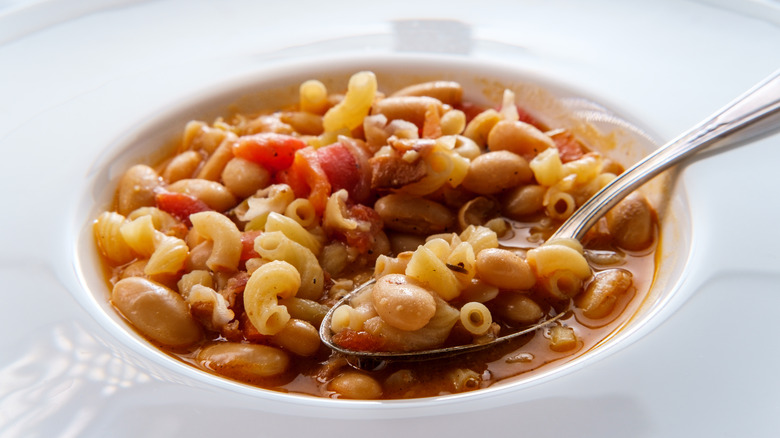
Ezume Images/Shutterstock
While pasta e fagioli is quite common in the United States, Pasta e fagioli Venetian style, or pasta e fagioli alla veneziana, is far from the classic you’ll see menu at Olive Garden. Oftentimes, Italian-American restaurants showcase pasta e fagioli with a thinner broth filled with sausage and a variety of vegetables. The traditional Italian version is much thicker and heartier with simpler ingredients.
The Venetian iteration of the soup is made with pasta and creamy borlotti beans, often cooked with pancetta, onion, garlic, and herbs, giving it an incredibly rich, savory flavor. Pasta e fagioli alla Veneziana tends to be thicker and heartier, almost like a stew. It’s typically finished with a drizzle of olive oil, minced parsley, and sometimes served with a crusty slice of bread. In the United States, ditalini pasta is commonly used in the preparation, but the Venetian version typically features tirache (a long pasta similar to tagliatelle) or bigoli, a whole-wheat pasta shape traditional to the Veneto region.
2. Salsa di noci
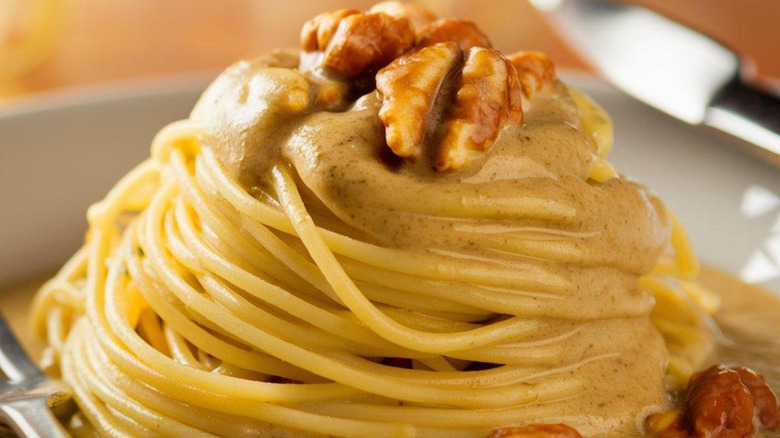
Food magic/Shutterstock
Another pasta dish you won’t really find is the legendary white pesto, or salsa di noci. This distinctive walnut-based sauce originates from the coastal region of Liguria in Italy and belongs to the pesto family of preparations. Salsa di noci remains largely unknown to Americans, as well as to Italians outside of Liguria. Unlike its famous cousin, basil pesto, salsa di noci hasn’t ventured outside the ragged coastline of its homeland. When passing through small villages in the region like Bonassola or Camogli, you’ll often notice graffiti at town entrances, proclaiming the area as either a basil pesto village or a salsa di noci village.
The preparation begins by blanching the walnuts to remove their skins. Then, they are ground with the oregano or marjoram, garlic, and pecorino cheese using a mortar and pestle or food processor. Salsa di noci purists will incorporate milk-soaked breadcrumbs to help create the sauce’s characteristic creamy texture. To complete it, olive oil is gradually added to achieve its delectable consistency and scrumptious, nutty, slightly fruity flavor. It is typically served with fresh pasta such as trofie or pansoti (a traditional Ligurian triangle-shaped ravioli filled with ricotta and herbs). However, it can also go well with homemade gnocchi or other short pasta shapes. You can even spread it on focaccia for a Ligurian-inspired appetizer.
3. Pasta alla zozzona
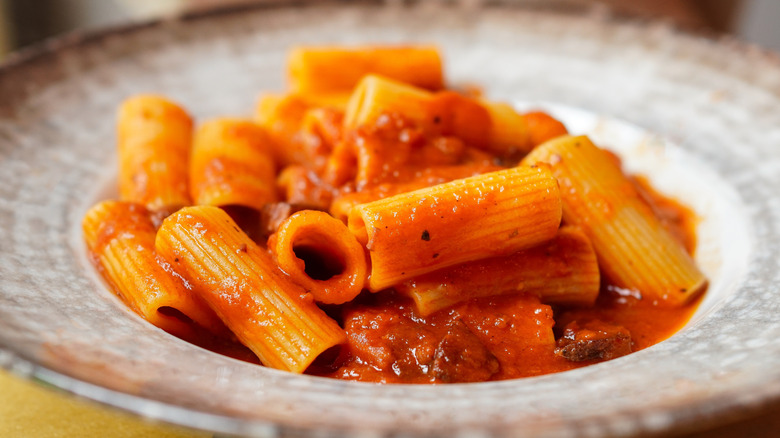
LaMerce/Shutterstock
Pasta alla zozzona emerged from the practical Italian cooking practice of combining whatever ingredients were on hand, specifically merging elements from three of Italy’s capital city, most beloved pasta dishes: carbonara, amatriciana, and cacio e pepe. The pasta dish was once a staple in New York City Italian restaurants and Rome’s historic trattoria; however, it has become overshadowed by its more refined predecessors.
The sauce combines guincale (cured pork jowl), egg yolk, grated pecorino cheese, ground black pepper, tomatoes, and occasionally, sausage-based meatballs. While it isn’t the lightest pasta dish around, the result is an incredibly rich and complex sauce that practically tastes like comfort in a bowl. Similar to carbonara, it requires a delicate hand to prevent the eggs from scrambling and balance the competing flavors without letting any single element dominate the entire dish. Today, you can find it scattered on a handful of menus across Rome, making a true old-school pasta dish only people privy to the city’s more experimental culinary scene.
4. Ragù di congilio
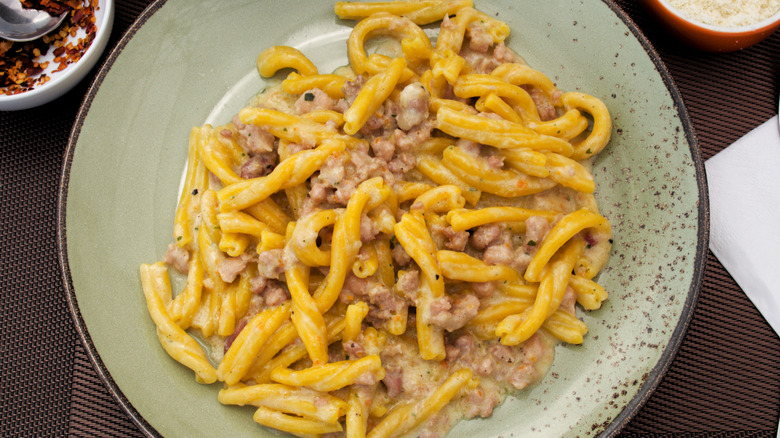
DBunting/Shutterstock
Another old-school pasta dish that has quietly retreated from kitchen tables in the States is ragù di coniglio or rabbit ragu. While it might sound a bit weird to make a ragu out of stewed rabbit meat, it’s actually incredibly common in Italy, especially in the regions of Tuscany and Umbria. You can find it served at agriturismos (working farms in Italy that offer hospitality services to guests), where rabbit is slowly braised with wine, herbs, and soffrito until it falls apart into silky strands that coat pasta perfectly. It completely disappeared in the U.S. as rabbit became a hard meat to source. American diners have grown quite uncomfortable with game meat, making this intensely flavorful sauce a true rarity outside traditional rural kitchens in Italy.
The ragu is typically slow-simmered for hours, resulting in a rich, gamey sauce with incredible umami flavor. It has the same consistency as braised short ribs, but with a much lighter, herbaceous flavor. It’s often served with freshly made tagliatelle or pappardelle with a glass of robust Chianti red wine. Next time you are vacationing in the rolling hills of Tuscany, try staying at an agriturismo and request this decadent pasta dish.
5. Pici all’aglione
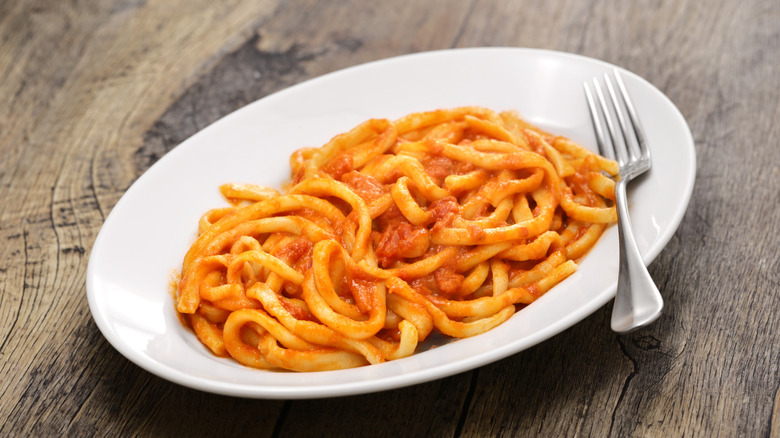
bonchan/Shutterstock
Tomato sauce has been gracing dining tables across the country for centuries, yet pici, the thick hand-rolled pasta it’s often paired with, has largely vanished. For those unfamiliar, pici all’aglione is a simple but perfect sauce consisting of tomatoes, garlic, and basil, where the irregular, rustic pasta shape is key to holding the sauce. You can find this pasta dish being served in trattorias scattered across the southern Tuscany region, specifically in the medieval town of Siena and in the hills of Val d’Orcia. Pici all’aglione is the epitome of cucina povera or poor man’s cuisine, due to its simple sauce and pasta consisting of only two ingredients: semolina flour and water.
Traditionally, people would roll the dough into long, uneven noodles directly on wooden tables, creating pasta with a wonderfully rustic texture that perfectly captures any sauce it touches. If you stumble inside a trattoria or osteria while driving around Tuscany, you might be able to see the chef rolling out fresh pici or drying them on unoccupied tables.
While traveling, you might be craving the mainstream classics, but try stepping outside your comfort zone and hunting down a pasta dish that’s native to the region you’re visiting. Who knows? You might just end up trying a unique pasta shape that you don’t really see anymore.
6. Pasta con le sarde alla Siciliana
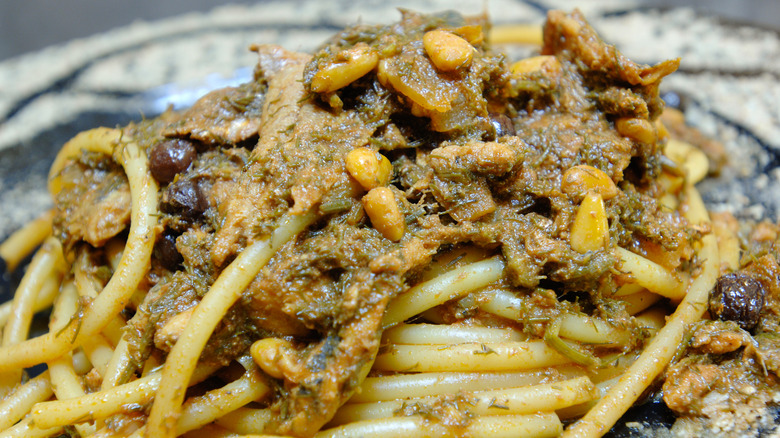
Francesco Vignali/Getty Images
Few dishes embody Sicily’s rich culinary history like pasta con le sarde alla Siciliana. If you haven’t tried it before, this elaborate Sicilian pasta dish combines freshly caught sardines, wild fennel fronds, pine nuts, raisins, and saffron. It’s traditionally served with either bucatini or perciatelli, but it can easily be made with any pasta shape. The sauce has unique flavor profile with raisins providing a subtle sweetness, the wild fennel fronds adding anise-like pop, and the sardines bringing the salty umami taste of the sea. The complex flavor and seasonal ingredients have made it nearly extinct outside of traditional Sicilian kitchens.
Pasta con le sarde alla Siciliana is a clear example of all of the conquests the largest island in the Mediterranean has endured. From Arabs who introduced saffron, pine nuts, and raisins to the Greeks who established the tradition of combining seafood with wild herbs to the Italians adding pasta into the mix — almost every culture that has dominated the island has made its mark on this delectable pasta dish. It’s quite hard to find it being served in the restaurants in the U.S., however. Iterations of the dish, such as the tinned fish pasta and other modern adaptations, have their roots in this unique Sicilian pasta dish.
7. Culurgiones alla ogliastrina
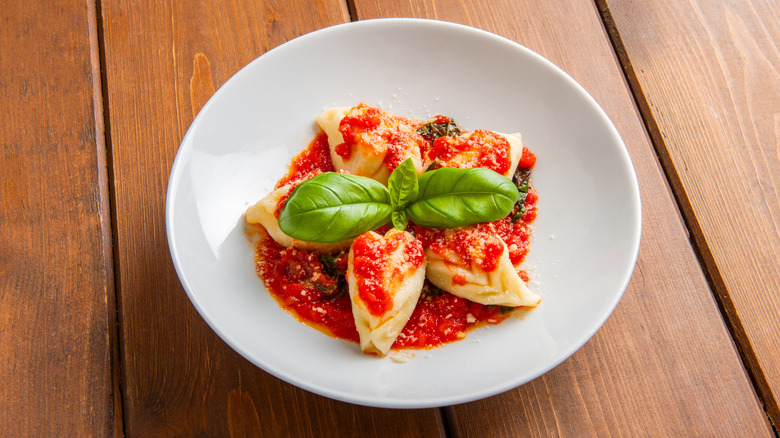
Alessio Orru/Shutterstock
At first glance, you might think culurgiones alla ogliastrina are either pierogi or overly stuffed dumplings. However, they are actually a Sardinian ravioli! Originating from the central eastern part of the island, Ogliastra, these elaborate pleated Sardinian ravioli are made to resemble wheat sheaves. These culurgiones are traditionally filled with a simple combination of potato, mint, and pecorino. They are typically served in a tomato-based sauce, topped with mint and shaved pecorino.
Today, authentic culurgiones alla ogliastrina are vanishing in Sardinia. The intricate hand-pleating technique made them a bit difficult to do in commercial kitchens, so restaurants began offering simplified versions or abandoning the dish entirely. When many Sardinian immigrants came to the U.S. after the Second World War, they had adapted to the traditions already established by Italian-Americans, thus allowing their specialties to fade on the voyage over the Atlantic. If you’ve visited Sardinia in recent years, though, you’ll notice there’s a rebirth in cuisine sparking across the island, with many young Sardinians learning the culinary techniques and preserving their tradition.


Dining and Cooking